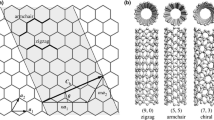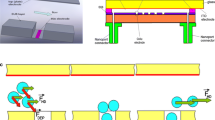Abstract
Trapping and manipulation of cells are essential operations in numerous studies in biology and life sciences. We discuss the realization of a Lab-on-a-Chip platform for dielectrophoretic trapping and repositioning of cells and microorganisms on a complementary metal oxide semiconductor (CMOS) technology, which we define here as Lab-on-CMOS (LoC). The LoC platform is based on dielectrophoresis (DEP) which is the force experienced by any dielectric particle including biological entities in non-uniform AC electrical field. DEP force depends on the permittivity of the cells, its size and shape and also on the permittivity of the medium and therefore it enables selective targeting of cells based on their phenotype. In this paper, we address an important matter that of electrode design for DEP for which we propose a three-dimensional (3D) octapole geometry to create highly confined electric fields for trapping and manipulation of cells. Conventional DEP-based platforms are implemented stand-alone on glass, silicon or polymers connected to external infrastructure for electronics and optics, making it bulky and expensive. In this paper, the use of CMOS as a platform provides a pathway to truly miniaturized lab-on-CMOS or LoC platform, where DEP electrodes are designed using built-in multiple metal layers of the CMOS process for effective trapping of cells, with built-in electronics for in-situ impedance monitoring of the cell position. We present electromagnetic simulation results of DEP force for this unique 3D octapole geometry on CMOS. Experimental results with yeast cells validate the design. These preliminary results indicate the promise of using CMOS technology for truly compact miniaturized lab-on-chip platform for cell biotechnology applications.














Similar content being viewed by others
References
C. Auth, 22-nm fully-depleted tri-gate CMOS transistors. IEEE Cust. Integr. Circ. Conf., 2012
S. Banerjee, B. E. White, L. Huang, B. J. Rego, S. O’Brien, I. P. Herman, Precise positioning of single-walled carbon nanotubes by ac dielectrophoresis. J. Vac. Sci. Technol. B 24(6) (2006)
A. Blake, Handbook of Mechanics, Materials, and Structures (Wiley, New York, 1985)
M. R. Buyong, F. Larki, M. S. Faiz, A. A. Hamzah, J. Yunas, B. Y. Majlis, A tapered aluminium microelectrode array for improvement of dielectrophoresis-based particle manipulation. Sensors (Basel) 15(5), 10973–10990 (2015)
C. D. Chin, V. Linder, S. K. Sia, Commercialization of microfluidic point-of-care diagnostic devices. Lab Chip 12, 2118–2134 (2012)
C. H. Chuang, T. F. Wu, C. H. Chen, K. C. Chang, J. W. Ju, Y. W. Huang, V. Van Nhan, Lab on a chip for multiplexed immunoassays to detect bladder cancer using multifunctional dielectrophoretic manipulations. Lab Chip 15(14), 3056–3064 (2015)
H. O. Fatoyinbo, N. A. Kadri, D. H. Gould, K. F. Hoettges, F. H. Labeed, Real-time cell electrophysiology using a multi-channel dielectrophoretic-dot microelectrode array. Electrophoresis 32(18), 2541–2549 (2011)
E. H. Francis, B. Taya, L. Yua, A. J. Panga, C. Iliescu, Electrical and thermal characterization of a dielectrophoretic chip with 3D electrodes for cells manipulation. Electrochim. Acta 52(8), 2862–2868 (2007)
D. R. Gossett, W. M. Weaver, A. J. Mach, S. C. Hur, H. T. K. Tse, W. Lee, H. Amini, D. D. Carlo, Label-free cell separation and sorting in microfluidic systems. Anal. Bioanal. Chem. 397(8), 3249–3267 (2010)
A. Henning, J. Henkel, F. F. Bier, R. Holzel, Label-free electrical quantification of the dielectrophoretic response of DNA. PMC Biophys. 1, 4 (2008)
T. B. Jones, Basic theory of dielectrophoresis and electrorotation. IEEE Eng. Med. Biol. Mag. 22(6), 33–42 (2003a)
T. B. Jones, Basic theory of dielectrophoresis and electrorotation. IEEE Eng. Med. Biol. Mag., 33–42 (2003b)
M. Kirschbaum, C. R. Guernth-Marschner, C.’e. S, A. de Pablo Pena, M. S. Jaeger, R. A. Kroczek, T. Schnelle, T. Mueller, C. Duschl, Highly controlled electrofusion of individually selected cells in dielectrophoretic field cages. Lab Chip 12, 443–450 (2012)
K. J. Kuhn, CMOS scaling for the 22 nm node and beyond: Device physics and technology. Proceedings of 2011 International Symposium on VLSI Technology, Systems and Applications, 2011 doi 10.1109/VTSA.2011.5872206
R. Kunikata, Y. Takahashi, M. Koide, T. Itayama, T. Yasukawa, H. Shiku, T. Matsue, Three dimensional microelectrode array device integrating multi-channel microfluidics to realize manipulation and characterization of enzyme-immobilized polystyrene beads. Sensors Actuators B 141, 256–262 (2009)
S. Patel, D. Showers, P. Vedantam, T.-R. Tzeng, S. Qian, X. Xuan, Microfluidic separation of live and dead yeast cells using reservoir-based dielectrophoresis. Biomicrofluidics 6(034102) (2012)
R. Pethig, Review Article—Dielectrophoresis: Status of the theory, technology, and applications. Biomicrofluidics 4(022811) (2010)
T. Shih, K. Chu, and C. Liu, A Programmable Biochip for the Applications of Trapping and Adaptive Multisorting Using Dielectrophoresis Array, J. Microelectromech. Syst., 16 (4), 816–825, 2007
J. Suehiro, R. Hamada, D. Noutomi, M. Shutou, M. Hara, Selective detection of viable bacteria using dielectrophoretic impedance measurement method. J. Electrost. 57, 157–168 (2003)
R. Thomas, H. Morgan, N. Green, Negative DEP traps for single cell immobilisation. Lab Chip 9, 1534–1540 (2009)
L. Ying, Q. Wang, Microfluidic chip-based technologies: emerging platforms for cancer diagnosis. BMC Biotechnol. 13, 76 (2013)
H. Yun, K. Kim, W. G. Lee, “Cell manipulation in microfluidics,”. Biofabrication 5(022001) (2013)
Author information
Authors and Affiliations
Corresponding author
Rights and permissions
About this article
Cite this article
Park, K., Kabiri, S. & Sonkusale, S. Dielectrophoretic lab-on-CMOS platform for trapping and manipulation of cells. Biomed Microdevices 18, 6 (2016). https://doi.org/10.1007/s10544-016-0030-x
Published:
DOI: https://doi.org/10.1007/s10544-016-0030-x




